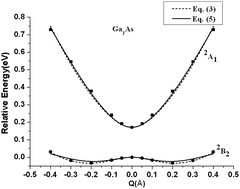Theoretical study on low-lying states of Ga2X (X = P, As) with coupled-cluster approaches
Abstract
Low-lying states of Ga2P and Ga2As are investigated with the equation-of-motion coupled-cluster approach for ionized states at the singles and doubles level (EOMIP-CCSD) as well as at the CCSDT-3 level together with CCSD, CCSD(T), and DFT. Except for the asymmetric stretching b2 mode of the 2B2 and 2A1 states, all these approaches provide structures, frequencies and adiabatic electron affinities that are in reasonable agreement with each other. According to our results, the lowest-energy state of these two molecules is the 2A′ state of Cs symmetry and the 2B2 state is the ground electronic state with C2v symmetry. As for the b2 mode, CCSD and CCSD(T) afford real frequencies for the 2B2 state, while EOM approaches and DFT with most exchange–correlation functionals give rise to imaginary frequencies. The 2B2 and 2A1 states couple with each other due to distortion along b2 mode through the pseudo-Jahn–Teller effect. Analysis on results shows that EOM approaches afford reasonable b2 frequencies for the two states and DFT approaches, except for BP86 and PBE, provide qualitatively correct b2 frequencies for the 2B2 state. In addition, a potential matrix is introduced to describe the vibronic coupling between the 2B2 and 2A1 states and parameters in the matrix are fitted to the adiabatic potential curves from EOMIP-CCSD results.


 Please wait while we load your content...
Please wait while we load your content...